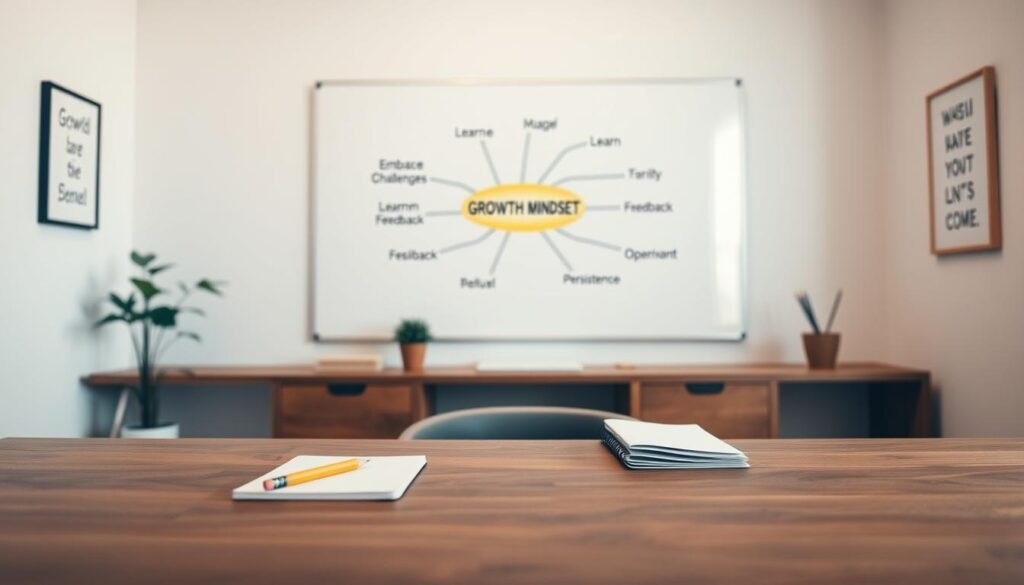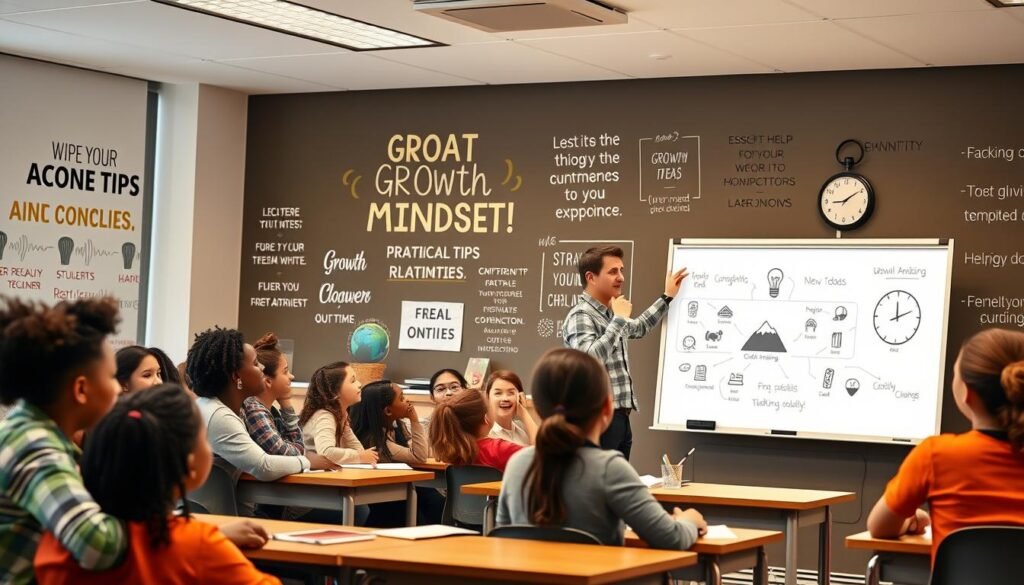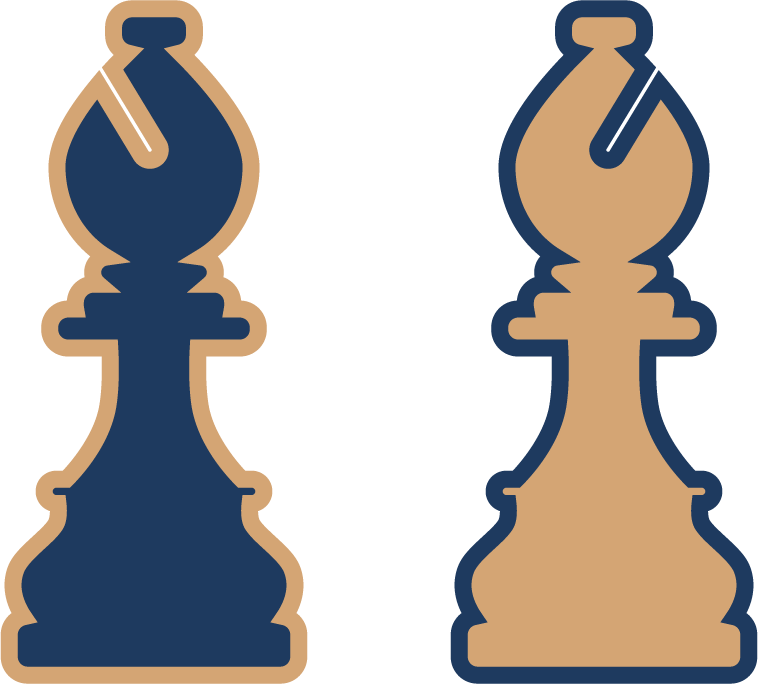Have you ever wondered why some learners thrive in the face of challenges while others give up? The answer lies in their mindset. Carol Dweck’s groundbreaking research reveals that those with a growth mindset view mistakes as opportunities, not failures. They understand that errors are essential for learning and growth.
Neuroplasticity, the brain’s ability to reorganize itself, supports this idea. Every mistake strengthens neural pathways, making future success more likely. For example, a student struggling with math might persist, knowing that effort leads to improvement. This mindset transforms obstacles into stepping stones.
Success coaches often emphasize the importance of analyzing errors. This practice builds resilience and academic confidence. Mistakes are not setbacks but tools for progress. Embracing this perspective can unlock untapped potential and lead to remarkable achievements.
Key Takeaways
- Growth mindset learners see mistakes as opportunities for improvement.
- Carol Dweck’s research highlights the link between mindset and academic success.
- Neuroplasticity allows the brain to adapt and grow through learning.
- Persistence in challenges leads to skill development and resilience.
- Error analysis is a key strategy for building academic confidence.
Understanding the Growth Mindset
The way individuals perceive their abilities can shape their entire learning journey. At the core of this perception lies the concept of the growth mindset, a belief that intelligence and abilities can be developed through effort and persistence. This idea, popularized by psychologist Carol Dweck, contrasts sharply with the fixed mindset, which views intelligence as static and unchangeable.
What is a Growth Mindset?
A growth mindset is rooted in the belief that skills and intelligence can grow with time and effort. Dweck’s research highlights that praising effort, rather than innate talent, encourages individuals to embrace challenges. For example, instead of saying, “You’re so smart,” saying, “You worked hard on this,” fosters resilience and a willingness to learn.
The Difference Between Growth and Fixed Mindsets
Those with a fixed mindset often avoid challenges, fearing failure. They might think, “I’m bad at math,” and give up. In contrast, individuals with a growth mindset see setbacks as opportunities. They respond with, “I need new strategies,” and persist. This adaptability is supported by Stanford University research, which shows that the brain’s neural pathways strengthen through learning.
Dweck’s “not yet” philosophy further illustrates this difference. Instead of labeling a task as a failure, it’s seen as a work in progress. This approach builds confidence and encourages continuous improvement. Whether in academics or athletics, the growth mindset fosters resilience and a passion for learning.
The Role of Mistakes in Learning
Mistakes are often seen as setbacks, but they hold the key to unlocking potential. In the learning process, errors play a crucial role in building resilience and fostering growth. Research shows that analyzing mistakes strengthens problem-solving neural pathways, making future success more likely.
For example, a case study in math education highlights iterative improvement through error correction. Students who reviewed their mistakes and adjusted their strategies showed significant progress. This approach, known as “productive failure,” has been widely studied in Singaporean classrooms, where it has led to deeper understanding and retention.
How Mistakes Foster Growth
Mistakes trigger the brain’s reward system, increasing dopamine-driven learning retention. When learners identify what went wrong, they engage in metacognition, a process that enhances self-awareness and problem-solving skills. Tools like BeforeSunset AI model this growth mindset by encouraging adaptive planning and reflection.
Why Mistakes Are Essential for Development
Failures are not endpoints but stepping stones. A study by AAAS found that STEM faculty with a growth-oriented approach reduced achievement gaps among learners. By viewing challenges as opportunities, individuals build confidence and adaptability. This mindset shift transforms obstacles into tools for progress.
How Do Students with a Growth Mindset See Their Mistakes
Embracing errors can lead to remarkable progress in learning. Those who adopt a growth-oriented approach understand that mistakes are not failures but essential steps in the process of improvement. Research shows that 57% of these learners actively seek feedback after errors, compared to only 23% with a fixed mindset.
Viewing Mistakes as Opportunities
For growth-focused individuals, errors are seen as learning opportunities. A study from the University of Michigan found that journaling improves error analysis by 41%. This practice helps learners identify patterns and develop better strategies. Northwestern University’s “Mistake Log” intervention further supports this, showing significant improvements in academic performance.
Teachers play a crucial role in framing mistakes positively. Phrases like “This error teaches me…” encourage learners to reframe setbacks as stepping stones. Peer mentoring programs also normalize struggle, creating a supportive environment where effort is celebrated over perfection.
Learning from Errors and Moving Forward
Effective error processing involves four steps: identification, analysis, strategy update, and implementation. For example, after missing deadlines, a student might adapt their time management techniques. This approach builds resilience and adaptability, key traits for long-term success.
Growth mindset classrooms show a 14% higher retention rate in STEM subjects. By viewing challenges as opportunities growth, learners develop confidence and problem-solving skills. This mindset shift transforms obstacles into tools for progress, unlocking untapped potential.
- Seek feedback to understand errors better.
- Use journaling to analyze and learn from mistakes.
- Reframe setbacks with positive language.
- Adapt strategies based on error analysis.
- Engage in peer mentoring to normalize struggle.
Strategies for Fostering a Growth Mindset
Building a growth mindset requires intentional strategies that focus on effort and learning environments. Research shows that small changes in classroom practices can significantly impact learners’ resilience and adaptability. By emphasizing effort over innate ability, educators can create a culture of continuous improvement.

Encouraging Effort Over Innate Ability
One effective approach is to praise the process rather than the outcome. Carol Dweck’s research found that process praise increases challenge-seeking by 33%. For example, instead of saying, “You’re so smart,” educators can say, “You worked hard on this problem.” This shift in language reinforces the value of effort and persistence.
Cooperative learning is another powerful tool. Studies show it boosts persistence by 40%. Group tasks encourage learners to support each other and view challenges as shared opportunities. Teachers can also use the word “yet” to frame unfinished work as a work in progress, improving assignment completion rates by 27%.
Creating a Supportive Learning Environment
A supportive environment is essential for fostering a growth mindset. Schools can implement a six-phase plan, starting with teacher mindset audits and professional development workshops. Classroom language guidelines and progress-focused grading policies further reinforce this approach.
Mistake analysis protocols and parent education nights ensure consistency across school and home environments. For example, Baltimore’s Growth Mindset Curriculum has shown remarkable results by integrating these strategies. Physical classroom setups that encourage risk-taking, such as flexible seating, also play a role in building confidence.
Constructive feedback scripts, like “This error teaches me…,” help learners reframe setbacks. Peer mentoring programs normalize struggle, creating a culture where effort is celebrated over perfection. These practices, combined with flipped classroom models, emphasize the process of learning and skill development.
The Benefits of a Growth Mindset
Adopting a growth mindset can transform the way individuals approach challenges and achieve success. This mindset fosters resilience, enhances academic performance, and builds essential skills for lifelong learning. Research consistently shows that those with a growth-oriented perspective outperform their peers in various areas.
Improved Resilience and Adaptability
A growth mindset strengthens resilience, enabling individuals to bounce back from setbacks. Studies reveal that mindset interventions reduce dropout rates by 63%. This adaptability is crucial in navigating challenges, whether in education or the workplace.
For example, during the COVID-19 pandemic, learners with a growth mindset adapted better to remote learning. They viewed obstacles as opportunities for progress, leading to improved emotional regulation and stress management. Yale’s CEI research highlights this connection, showing significant emotional benefits.
Enhanced Academic Performance
Growth mindset learners achieve higher academic success. A 2022 national study found a 17% GPA increase among these individuals. Specific subject improvements include:
- Math: 12% gains in problem-solving skills.
- Writing: 9% increase in revision depth.
- Science: 15% rise in experimental persistence.
Longitudinal studies also show that this mindset positively impacts career success. Microsoft’s corporate training programs emphasize growth principles, resulting in higher employee adaptability and innovation.
By fostering a belief in continuous improvement, a growth mindset unlocks potential and drives progress in all areas of life.
Practical Tips for Students and Educators
Transforming challenges into opportunities starts with the right mindset. Both teachers and learners can benefit from actionable strategies that foster growth and resilience. Here’s how to make it happen.

How Teachers Can Promote a Growth Mindset
Educators play a vital role in shaping learners’ attitudes. Start by incorporating weekly reflections, which boost mindset development by 22%. Focus on hard work and effort, using a 5:1 process-to-outcome feedback ratio for optimal results.
Here are eight actionable classroom strategies:
- Host “Mistake of the Week” discussions to normalize errors.
- Add growth-focused supplements to report cards.
- Teach mini-lessons on brain plasticity.
- Encourage process-based peer reviews.
- Develop challenge portfolios to track progress.
- Introduce growth mindset role models.
- Use feedback stem sentences like “This error teaches me…”
- Implement mistake recovery protocols to build resilience.
How Students Can Develop a Growth Mindset
Learners can take charge of their growth with practical tools. Growth journaling, for example, increases self-efficacy by 38%. Pair this with SMART goal templates and error analysis worksheets for a structured approach.
Consider these tips for personal development:
- Use neuroplasticity visualization exercises to understand brain growth.
- Partner with a growth buddy for accountability.
- Track progress with process-focused apps.
- Engage parents with guidelines to support learning at home.
By focusing on hard work and consistent effort, both teachers and learners can create an environment where growth thrives.
Conclusion
Adopting a growth-oriented approach transforms challenges into stepping stones for success. Research shows that 79% of top universities now integrate mindset training, highlighting its importance in education. This shift not only boosts academic performance but also increases lifetime earnings by 14%.
Neuroplasticity plays a key role in this process. Every mistake strengthens neural pathways, fostering resilience and adaptability. By viewing errors as opportunities, individuals develop problem-solving skills and confidence. This mindset encourages continuous improvement and long-term success.
Systemic educational reform is essential to support this shift. Emerging technologies, such as AI-driven learning tools, further enhance mindset development. Schools and institutions can implement resources like growth mindset pledge templates to encourage this transformation.
By redefining mistakes as learning tools, we unlock untapped potential. National resources and support systems ensure this approach becomes a standard in education. Embracing this perspective paves the way for a brighter, more resilient future.
FAQ
What is a growth mindset?
A growth mindset is the belief that abilities and intelligence can be developed through effort, learning, and persistence. It emphasizes embracing challenges and viewing failures as opportunities for growth.
How does a growth mindset differ from a fixed mindset?
A fixed mindset assumes that intelligence and abilities are static, while a growth mindset focuses on the potential for improvement through hard work and effective strategies.
Why are mistakes important in the learning process?
Mistakes are essential because they provide valuable feedback, highlight areas for improvement, and encourage problem-solving, ultimately fostering resilience and progress.
How can teachers promote a growth mindset in the classroom?
Teachers can encourage effort over innate ability, provide constructive feedback, and create a supportive environment where students feel safe to take risks and learn from errors.
What are the benefits of adopting a growth mindset?
A growth mindset enhances resilience, adaptability, and academic performance by motivating individuals to embrace challenges and persist through difficulties.
How can students develop a growth mindset?
Students can focus on the learning process, set achievable goals, and view challenges as opportunities to grow rather than obstacles to avoid.
How does Carol Dweck’s research support the concept of a growth mindset?
Carol Dweck’s research highlights the transformative power of believing in the potential for growth, showing that individuals with this mindset achieve greater success and fulfillment.
